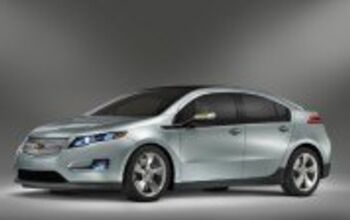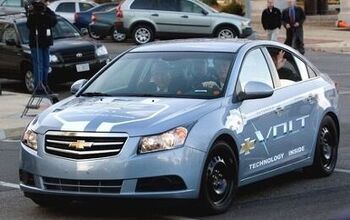Volt Birth Watch 138: Watching the Defectives
Car and Driver recently got a test drive in a Cruze-bodied Chevy Volt mule, and wrote up the experience with the fawning credulousness of a buff book that desperately wants to be first in line for an equally subservient “exclusive first road test.” If such an event ever comes to pass, of course. But even amidst the regurgitated GM talking points, C&D manages to (gasp) raise a troubling question: if this vehicle is going to be road-ready in just over a year, why is The General limiting test drives to electric mode?
An answer (of sorts) is supplied by Volt line engineer Tony Posawatz. “The work being done by the development guys as we speak is to create a gentle feathering of engine rpm so you don’t even notice that the engine kicks in. And to try to operate at the right points and to transition the rpm points depending on the load you’re getting—to behave like someone would want it to behave. You may get into a position under an extreme grade or hill climb, where the engine rpm will be pretty loud—running pretty hard. At a certain point in time that rpm will be relatively unpleasant. This is the challenge of different road loads: how can we keep the NVH reasonable for a customer?”
How indeed?
Gm-volt.com‘s Lyle Dennis read the C&D writeup, and doesn’t like the nasty implication that somehow the Volt could be less than perfect. His antidote to C&D‘s skepticism-lite? Hearsay! “While I was at the Milford Proving Grounds,” writes Dennis, “I was told that many people who drive the car through the transition often don’t notice the engine going on and that it is not abrupt. Once running, RPMs are known to operate at several fixed points not matched to the accelerator and thus theoretically the engine could feel unnatural.”
But the fact remains: since the Volt’s “range-extending” ICE will send electric power directly to the wheels after battery depletion, overtaking and hill-climbing could get a little noisy (not to mention slow and possibly dangerous) with only a 1.4T engine running things. The fact that GM won’t let anyone drive the thing in “generator mode” speaks volumes.
Not that we’re making a big deal about it. After all, David Letterman has learned the price of Volt-bashing: a stern blogging-to from GM VP for Grumpy Outbursts, Maximum Bob Lutz. Lutz lays into Letterman’s “stupid human trick” at GM’s Fastlane blog, his first such post in ages.
“I don’t know if you happened to catch David Letterman Wednesday night. Frankly, I didn’t, nor did many of my colleagues at GM. But you can bet the clip of Dave interviewing Elon Musk of Tesla Motors has certainly made the rounds here, and has people up in arms, particularly the Chevrolet Volt team.
Mr. Letterman made some gratuitously derogatory remarks about the Volt’s range, calling it “insane” and “ridiculous,” and in general appeared woefully uninformed about the Volt. For one thing, he said its 40-mile range wouldn’t get him down the driveway to pick up the newspaper.
Now, if he is that uninformed, I must point out that it’s not his fault, it’s ours. We should do a better job of making sure that Dave and everyone else who is in position to comment on national TV about our products has the right information, whether they use that information or not. Perhaps if we’d hired Drew Barrymore to be the spokesperson for the vehicle we’d have commanded more of his attention. Regardless, we’d like to rectify the situation.”
Lutz’s solution? Get Letterman over to the Milford Proving Grounds And Re-Education Center for a test drive. Uh, Bob, they tried that already, and unless you’re part of the gm-volt.com varisty cheer squad that tends to raise more questions than it answers, the answer isn’t stunts aimed at getting people “the right” information. Transparency and honesty are the only things that will really answer the skeptics.
More by Edward Niedermeyer
Latest Car Reviews
Read moreLatest Product Reviews
Read moreRecent Comments
- 1995 SC I wish they'd give us a non turbo version of this motor in a more basic package. Inline Sixes in trucks = Good. Turbos that give me gobs of power that I don't need, extra complexity and swill fuel = Bad.What I need is an LV1 (4.3 LT based V6) in a Colorado.
- 1995 SC I wish them the best. Based on the cluster that is Ford Motor Company at the moment and past efforts by others at this I am not optimistic. I wish they would focus on straigtening out the Myriad of issues with their core products first.
- El Kevarino There are already cheap EV's available. They're called "used cars". You can get a lightly used Kia Niro EV, which is a perfectly functional hatchback with lots of features, 230mi of range, and real buttons for around $20k. It won't solve the charging infrastructure problem, but if you can charge at home or work it can get you from A to B with a very low cost per mile.
- Kjhkjlhkjhkljh kljhjkhjklhkjh haaaaaaaaaaahahahahahahahaha
- Kjhkjlhkjhkljh kljhjkhjklhkjh *Why would anyone buy this* when the 2025 RamCharger is right around the corner, *faster* with vastly *better mpg* and stupid amounts of torque using a proven engine layout and motivation drive in use since 1920.


































Comments
Join the conversation
"As I mentioned previously on another blog the Volt should have been a Buick so it wouldn’t have been so price sensitive." I agree with that. I read someplace that decades ago Buick's got the new stuff to field test on consumers - HEI ignition, turbo V6, electronic fuel injection, etc.
The genset is used to sustain the charge of the battery at about 30%, give or take. That give or take is the buffer needed to supply power for acceleration, hill climbing, etc. When the genset kicks on, it delivers enough power to keep the battery at about 30% on average throughout the remainder of your drive. Which is why it's called "charge sustaining mode". I'm sure GM knows how to create a nicely feathered, low NVH, genset. The tweaking is likely just to get it right for the specific Volt application. The devil is in the details, and anyone who has worked on product design and development knows that it's never just as simple as it looks on paper. This isn't big news. I'm sure GM has lots of tweaking left to do on multilple systems. Bear in mind that, for GM, it needs to work seamlessly around the globe, in various extreme climates, under all driving conditions, all of which have an effect on performance. It's not good enough for it just to work for you, it needs to work for everyone, everywhere. How long did Honda work on the FX Clarity behind the scenes before releasing itto the public? With the Volt, we are getting a reasonably good view of the design and development process, which may be foreign to most people, but is in fact very normal. This is how it happens people, it's not a straight line from concept to finished product, there is always testing and tweaking, and things cropping up that are not expected. While seeing the development mules in action is cool, the proof (or lack thereof) will be in the finished product, not before.